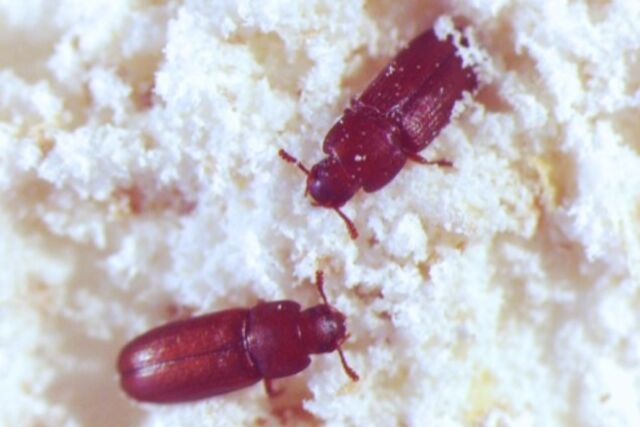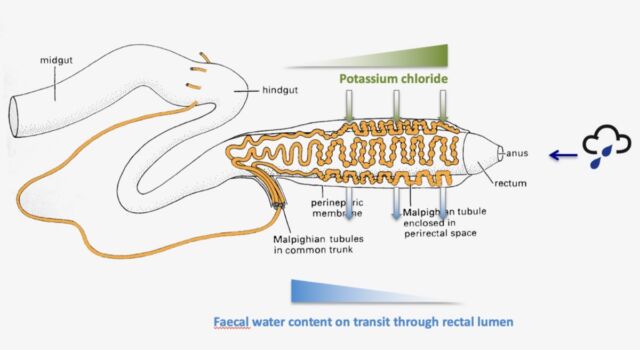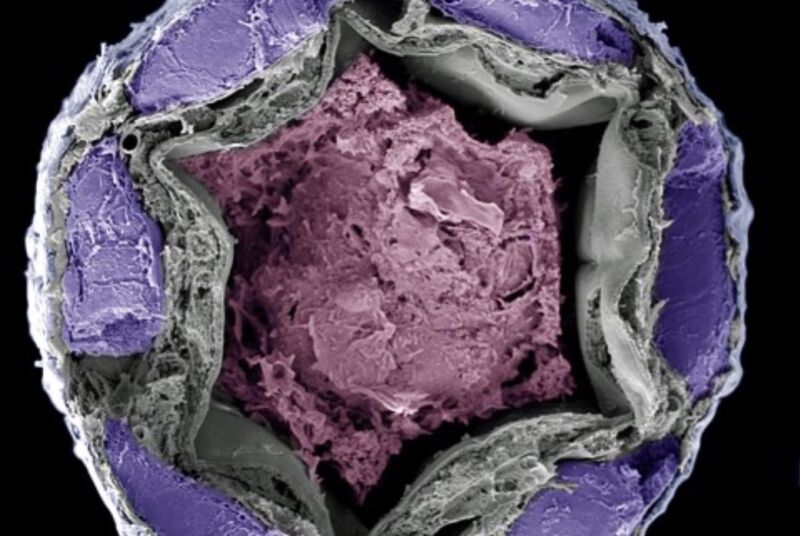The humble red flour beetle (Tribolium castaneum) is a common pantry pest feeding on stored grains, flour, cereals, pasta, biscuits, beans, and nuts. It's a remarkably hardy creature, capable of surviving in harsh arid environments due to its unique ability to extract fluid not just from grains and other food sources, but also from the air. It does this by opening its rectum when the humidity of the atmosphere is relatively high, absorbing moisture through that opening and converting it into fluid that is then used to hydrate the rest of the body.
Scientists have known about this ability for more than a century, but biologists are finally starting to get to the bottom (ahem) of the underlying molecular mechanisms, according to a March paper published in the Proceedings of the National Academies of Science. This will inform future research on how to interrupt this hydration process to better keep red flour beetle populations in check, since they are highly resistant to pesticides. They can also withstand even higher levels of radiation than the cockroach.
There are about 400,000 known species of beetle roaming the planet although scientists believe there could be well over a million. Each year, as much as 20 percent of the world's grain stores are contaminated by red flour beetles, grain weevils, colourado potato beetles, and confused flour beetles, particularly in developing countries. Red flour beetles in particular are a popular model organism for scientific research on development and functional genomics. The entire genome was sequenced in 2008, and the beetle shares between 10,000 and 15,000 genes with the fruit fly (Drosophila), another workhorse of genetics research. But the beetle's development cycle more closely resembles that of other insects by comparison.

The rectums of most mammals and insects absorb any remaining nutrients and water from the body's waste products prior to defecation. But the red flour beetle's rectum is a model of ultra-efficiency in that regard. The beetle can generate extremely high salt concentrations in its kidneys, enabling it to extract all the water from its own feces and recycle that moisture back into its body.
"A beetle can go through an entire life cycle without drinking liquid water," said co-author Kenneth Veland Halberg, a biologist at the University of Copenhagen. "This is because of their modified rectum and closely applied kidneys, which together make a multi-organ system that is highly specialized in extracting water from the food that they eat and from the air around them. In fact, it happens so effectively that the stool samples we have examined were completely dry and without any trace of water." The entire rectal structure is encased in a perinephric membrane.
Halberg et al. took took scanning electron microscopy images of the beetle's rectal structure. They also took tissue samples and extracted RNA from lab-grown red flour beetles, then used a new resource called BeetleAtlas for their gene expression analysis, hunting for any relevant genes.
One particular gene was expressed sixty times more in the rectum than any other. Halberg and his team eventually honed in a group of secondary cells between the beetle's kidneys and circulatory system called leptophragmata. This finding supports prior studies that suggested these cells might be relevant since they are the only cells that interrupt the perinephric membrane, thereby enabling critical transport of potassium chloride. Translation: the cells pump salts into the kidneys to better harvest moisture from its feces or from the air.

The next step is to build on these new insights to figure out how to interrupt the beetle's unique hydration process at the molecular level, perhaps by designing molecules that can do so. Those molecules could then be incorporated into more eco-friendly pesticides that target the red flour beetle and similar pests while not harming more beneficial insects like bees.
"Now we understand exactly which genes, cells and molecules are at play in the beetle when it absorbs water in its rectum. This means that we suddenly have a grip on how to disrupt these very efficient processes by, for example, developing insecticides that target this function and in doing so, kill the beetle," said Halberg. "There is twenty times as much insect biomass on Earth than that of humans. They play key roles in most food webs and have a huge impact on virtually all ecosystems and on human health. So, we need to understand them better."
DOI: PNAS, 2023. 10.1073/pnas.2217084120 (About DOIs).



3175x175(CURRENT).thumb.jpg.b05acc060982b36f5891ba728e6d953c.jpg)
Recommended Comments
There are no comments to display.
Join the conversation
You can post now and register later. If you have an account, sign in now to post with your account.
Note: Your post will require moderator approval before it will be visible.